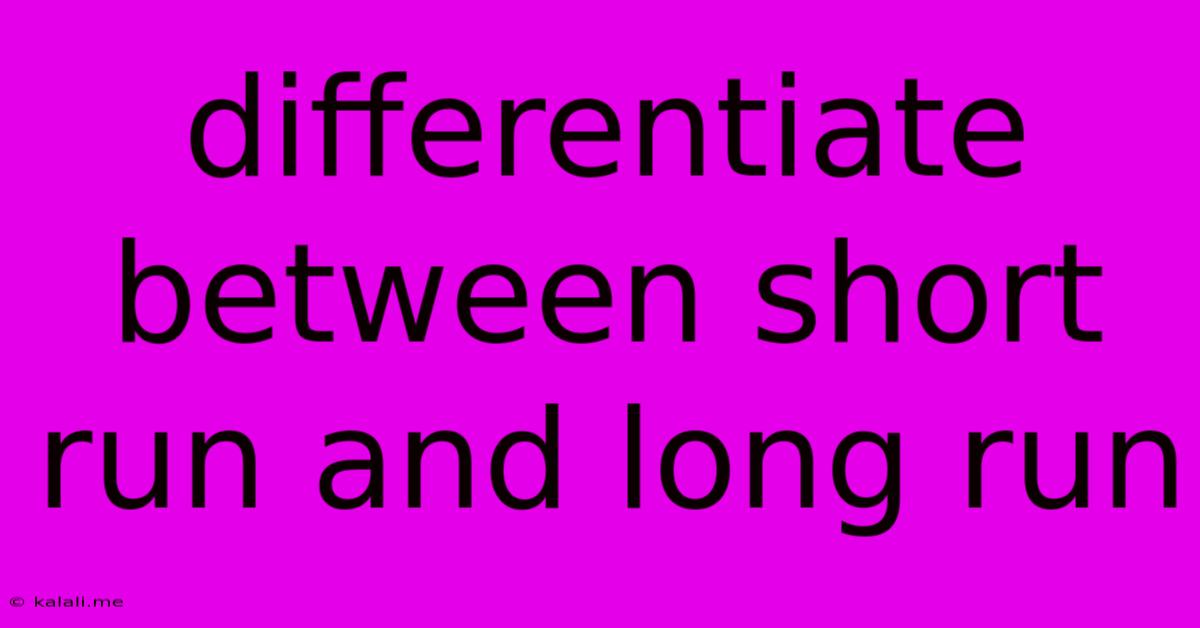Differentiate Between Short Run And Long Run
Kalali
Jun 15, 2025 · 3 min read

Table of Contents
Differentiating Short Run and Long Run: A Crucial Economic Concept
Understanding the difference between the short run and the long run is fundamental to grasping many economic concepts. While seemingly straightforward, the distinction isn't about a specific timeframe like "one year" versus "ten years." Instead, it hinges on the flexibility of a firm's inputs. This article will delve into the key differences, providing clarity on this crucial economic concept and its implications.
What constitutes the short run and the long run? The short run is defined as a period where at least one input is fixed. This usually refers to capital, such as factory size, machinery, or even the number of skilled workers whose contracts aren't easily adjustable. The long run, conversely, is a period where all inputs are variable. Businesses have the flexibility to adjust their size, technology, and workforce to changing market conditions. The length of these periods varies significantly across different industries and firms. A small bakery might adjust its production in the long run within months, while a large automobile manufacturer might require several years.
Key Differences Between Short Run and Long Run
Here's a table summarizing the core distinctions:
| Feature | Short Run | Long Run |
|---|---|---|
| Fixed Inputs | At least one input is fixed (e.g., capital) | No fixed inputs; all inputs are variable |
| Variable Inputs | Some inputs are variable (e.g., labor) | All inputs are variable |
| Output Adjustment | Limited capacity to adjust output | Greater capacity to adjust output |
| Cost Structure | Both fixed and variable costs | Primarily variable costs |
| Time Horizon | Relatively short period | Relatively long period |
| Firm's Flexibility | Less flexible in responding to changes | More flexible in responding to changes |
| Economic Decisions | Focus on managing existing capacity | Focus on expansion, contraction, and innovation |
Implications of the Short Run and Long Run Distinction
The distinction between short-run and long-run analysis has significant implications for various economic decisions:
- Production Decisions: In the short run, firms must work with their existing capital. They can adjust output by changing variable inputs like labor and raw materials. However, in the long run, firms can alter their capital stock to optimize production for various output levels. This impacts production functions and cost curves.
- Pricing Decisions: Short-run pricing strategies often involve covering variable costs and aiming for some contribution to fixed costs. The long run allows for a broader perspective considering economies of scale, competition, and the overall market structure.
- Investment Decisions: Long-run decisions involve significant capital investment, such as building new facilities or upgrading technology. This requires careful consideration of long-term market trends and demand projections. Short-run investment decisions tend to be more incremental and reactive.
- Market Structure Analysis: Understanding the time horizon influences how we analyze market structures like perfect competition and monopoly. In the short run, firms may have limited flexibility to enter or exit a market, while the long run allows for greater adjustments, influencing market equilibrium and profits.
Examples illustrating the difference
Imagine a coffee shop:
- Short run: If demand suddenly increases, the shop might hire more baristas (variable input) to serve more customers. However, it cannot quickly expand its seating capacity (fixed input).
- Long run: If the sustained increase in demand continues, the coffee shop might expand its premises, purchase new equipment, and potentially even open a new branch.
In conclusion, while the terms "short run" and "long run" lack precise temporal definitions, they represent crucial distinctions in economic analysis. The flexibility of a firm's inputs defines the timeframe and significantly impacts decisions related to production, pricing, investment, and market dynamics. Understanding this distinction provides valuable insights into how businesses operate and adapt to changing market conditions.
Latest Posts
Latest Posts
-
Which Of The Following Has Potential Energy
Jun 16, 2025
-
Roman Numerals That Add To 35
Jun 16, 2025
-
Which Of The Following Statements About Development Is True
Jun 16, 2025
-
What Is The Lcm Of 14 And 18
Jun 16, 2025
-
Kelvin Is The Si Unit For Which Physical Quantity
Jun 16, 2025
Related Post
Thank you for visiting our website which covers about Differentiate Between Short Run And Long Run . We hope the information provided has been useful to you. Feel free to contact us if you have any questions or need further assistance. See you next time and don't miss to bookmark.